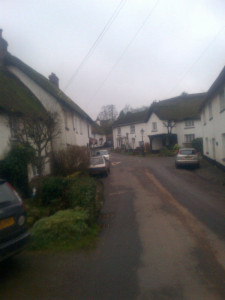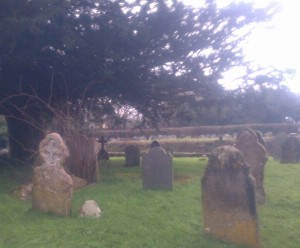The Village Landscape
The landscape of English literature is dotted with vividly drawn and wonderful fictional places, some traditional – Casterbridge and Coketown, Barchester and Sanditon – and some less so – Ankh Morpork and Khazad-dum. Without wishing in any way to make comparisons, (for fear of coming off much, much the worse) the village has its own little place in that shifting literary cartography.
 Yet it is never named and its location is not signalled. It is rural, in or near ‘the Vale’ (‘The Lion’), though about fifteen miles east of a town (also unnamed, but appearing in ‘Not Even Waving’ and ‘The Fourth Estate’). We know where it isn’t – in ‘Sunday‘ Paul Marshall refers to Biggin Hill and Northolt as being ‘down south’. In the same story Ray Marshall says that Cambridgeshire is ‘not far away’, but this village is not located near to Crabbe’s late eighteenth century version, nor to Gray’s ( though his Elegy appears in ‘Open Gardens’ ). Its population doesn’t give the reader any clue either. There are some ‘old’, indigenous families, like the Marshalls and the Lucks, but many ‘incomers’, such as Hari Mistry (‘The Summer Fete’) from ‘Yorkshire folk’, Mandeep Dhaliwal, (‘Harvest’) who has a stubborn Bradford accent, Basil de Silva and family are from Sri Lanka and Howard Goodman (‘Open Gardens’) is from Manchester. There is a larger village called Bridge several miles further east, one of two named fictional locations in the whole book, (the other is Lockley) though there are references to real places like London and Duxford.
Yet it is never named and its location is not signalled. It is rural, in or near ‘the Vale’ (‘The Lion’), though about fifteen miles east of a town (also unnamed, but appearing in ‘Not Even Waving’ and ‘The Fourth Estate’). We know where it isn’t – in ‘Sunday‘ Paul Marshall refers to Biggin Hill and Northolt as being ‘down south’. In the same story Ray Marshall says that Cambridgeshire is ‘not far away’, but this village is not located near to Crabbe’s late eighteenth century version, nor to Gray’s ( though his Elegy appears in ‘Open Gardens’ ). Its population doesn’t give the reader any clue either. There are some ‘old’, indigenous families, like the Marshalls and the Lucks, but many ‘incomers’, such as Hari Mistry (‘The Summer Fete’) from ‘Yorkshire folk’, Mandeep Dhaliwal, (‘Harvest’) who has a stubborn Bradford accent, Basil de Silva and family are from Sri Lanka and Howard Goodman (‘Open Gardens’) is from Manchester. There is a larger village called Bridge several miles further east, one of two named fictional locations in the whole book, (the other is Lockley) though there are references to real places like London and Duxford.
The village is an old one, it goes back to Tudor times (‘The Lion’) and the landscape around it is an ancient one (‘In Calley Wood’). If, as is said in another place specific work, ‘Time present and time past Are both perhaps present in time future’ then this sleepy place overflows with accreted activity. It has seen its share of momentous events and there are reminders of them all around (‘Sunday‘). The early industrial revolution touched upon it – a canal runs through it, meeting a larger version out in the countryside (‘Mixed Doubles’). The church, St Agnes, and the green are at the centre of the older part of the village, from which Victorian and more modern housing radiate around the formal, early twentieth century park, and there is a 1930s municipal development on its edge. Employment and industry is largely rural, people work in farming and land management, or in local services. Many inhabitants, like Scott Castle and Lynda Marshall, commute to work in the town and a conurbation isn’t too far away (where Kings Electronics started out ). It has three schools, Priory Road Primary, Furzedown Comprehensive and St Jerome’s College (a private, boarding, institution). High Acres Hospital sits outside the village in a former grand country house (‘The Volunteer’ and ‘Accident and Emergency’). But it is also a modern, twenty first century village, with modern technology and modern mores.
it, meeting a larger version out in the countryside (‘Mixed Doubles’). The church, St Agnes, and the green are at the centre of the older part of the village, from which Victorian and more modern housing radiate around the formal, early twentieth century park, and there is a 1930s municipal development on its edge. Employment and industry is largely rural, people work in farming and land management, or in local services. Many inhabitants, like Scott Castle and Lynda Marshall, commute to work in the town and a conurbation isn’t too far away (where Kings Electronics started out ). It has three schools, Priory Road Primary, Furzedown Comprehensive and St Jerome’s College (a private, boarding, institution). High Acres Hospital sits outside the village in a former grand country house (‘The Volunteer’ and ‘Accident and Emergency’). But it is also a modern, twenty first century village, with modern technology and modern mores.
There are certainly aspects of the village which reflect its author’s idea of England. It is a safe haven for the refugee, from close by (‘In the Salon’ ) and further afield (‘Open Gardens’), with its respect for law, its tolerance and dislike of extremes and its refusal to take itself too seriously. But there is also a tendency towards complacency and traditionalism and it’s not immune to current English controversies, such as immigration and the mobile nature of labour (‘The Lion’) and the right to free speech as compared to the fomenting of hatred (‘The Fourth Estate’). It is not urban England and has nothing of the metropolitan about it, though neither is it modern, socially conservative, rural England.
The Village is, above all, a place of the imagination. All it’s antecedents are literary – the settlements of Wilder, Thomas, White and Keillor – not physical. Many of the stories contain literary allusions and, in some instances, direct quotations or near quotations, from the specific works which inspired them. At its beginning, this article mentioned four famous ‘traditional’ literary places. Three of the four writers who created those places are referenced through quotations hidden in the text of the Tales they inspired. There are others, not just novelists, but playwrights and poets too, who have direct quotations, and some indirect ones.
Please feel free to try and identify them and let The Story Bazaar know when you do, via info@thestorybazaar.com ( so as not to spoil it for other readers )! I’ll think of a prize for the first person to identify all the literary allusions!


 RSS – Posts
RSS – Posts